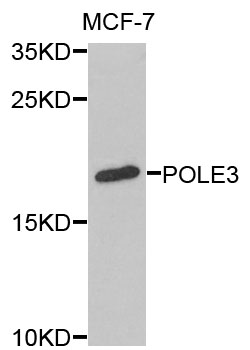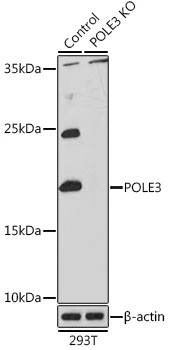DNA polymerase epsilon 3 antibody [N1C3]
GTX116557
ApplicationsImmunoFluorescence, Western Blot, ImmunoCytoChemistry, ImmunoHistoChemistry, ImmunoHistoChemistry Paraffin
Product group Antibodies
TargetPOLE3
Overview
- SupplierGeneTex
- Product NameDNA polymerase epsilon 3 antibody [N1C3]
- Delivery Days Customer9
- Application Supplier NoteWB: 1:500-1:3000. ICC/IF: 1:100-1:1000. IHC-P: 1:100-1:1000. *Optimal dilutions/concentrations should be determined by the researcher.Not tested in other applications.
- ApplicationsImmunoFluorescence, Western Blot, ImmunoCytoChemistry, ImmunoHistoChemistry, ImmunoHistoChemistry Paraffin
- CertificationResearch Use Only
- ClonalityPolyclonal
- Concentration1.01 mg/ml
- ConjugateUnconjugated
- Gene ID54107
- Target namePOLE3
- Target descriptionDNA polymerase epsilon 3, accessory subunit
- Target synonymsCHARAC17, CHRAC17, CHRAC2, YBL1, p17, DNA polymerase epsilon subunit 3, CHRAC-17, DNA polymerase II subunit 3, DNA polymerase epsilon p17 subunit, DNA polymerase epsilon subunit p17, arsenic transactivated protein, asTP, chromatin accessibility complex 17 kDa protein, chromatin accessibility complex subunit 2, histone fold protein CHRAC17, huCHRAC17, polymerase (DNA directed), epsilon 3 (p17 subunit), polymerase (DNA directed), epsilon 3, accessory subunit, polymerase (DNA) epsilon 3, accessory subunit
- HostRabbit
- IsotypeIgG
- Protein IDQ9NRF9
- Protein NameDNA polymerase epsilon subunit 3
- Scientific DescriptionPOLE3 is a histone-fold protein that interacts with other histone-fold proteins to bind DNA in a sequence-independent manner. These histone-fold protein dimers combine within larger enzymatic complexes for DNA transcription, replication, and packaging.[supplied by OMIM]
- Storage Instruction-20°C or -80°C,2°C to 8°C
- UNSPSC12352203
References
- Zou W, Wang Z, Xiong M, et al. Human Parvovirus B19 Utilizes Cellular DNA Replication Machinery for Viral DNA Replication. J Virol. 2018,92(5). doi: 10.1128/JVI.01881-17Read this paper







